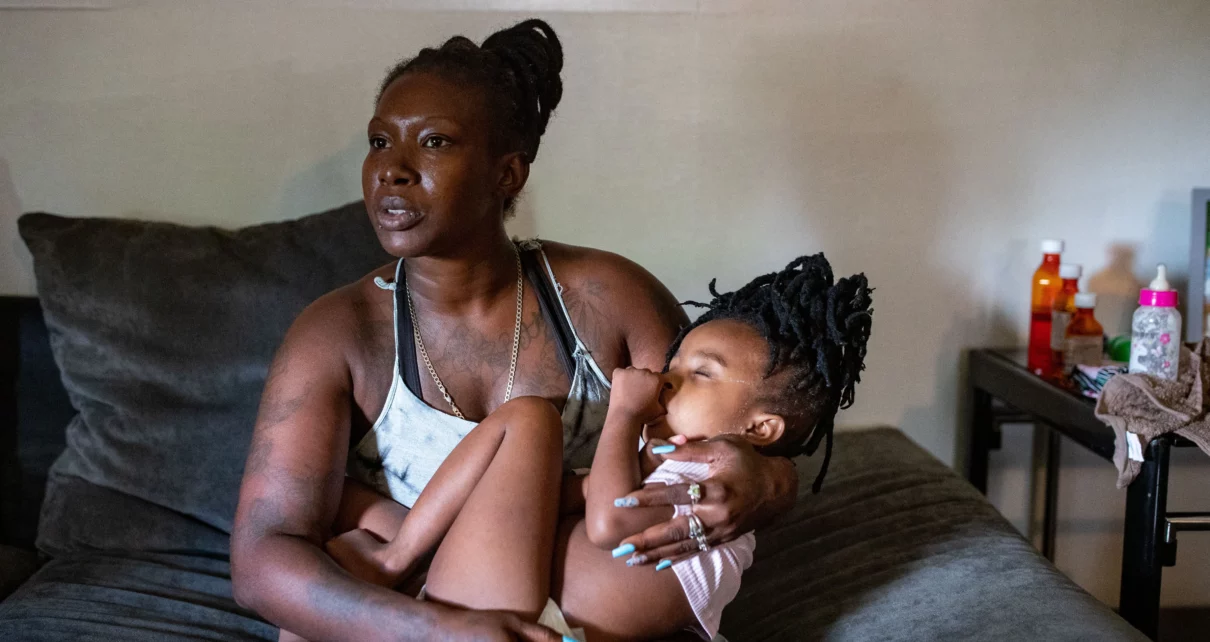
Jasmine Brown plays with her youngest son, Elijah, in the backyard of her home in Marion County, Fla., Thursday, Oct. 5, 2023. (Azhalia Pottinger/Fresh Take Florida)
Jasmine Brown, an Ocala mother of four, has been on waitlists at some local daycare centers for almost two years. Unable to find a program she can afford that could enroll her 1- and 3-year-old sons together, she’s split them between two different centers this year.
The 29-year-old single parent spent 18 months out of work due to struggles to find safe and affordable child care.
“If you can’t work, you can’t provide,” she said. “It’s this loop that you get stuck in and it’s so frustrating.”
The obstacles that come with finding child care are only growing as a program providing child care funding to states during the pandemic ended last month. The stimulus money was part of a federal $24 billion program – including $1.5 billion for Florida alone – to help early learning education centers through the pandemic.
An estimated 2,196 child care programs in Florida are expected to close, and 212,721 children are predicted to lose care in the state due to the loss in funding, according to a report in June by the New York-based Century Foundation, a progressive think tank.
Throughout the U.S., 3.2 million children could lose care and 70,000 programs are at risk of closing, according to the report.
The organization estimates that affected parents, who are disproportionately women, could lose over $9 billion per year in earnings if they were unable to secure affordable child care and forced to leave the workforce.
 Jasmine Brown pushes her four kids on swing in the backyard of their home in Marion County, Fla., Thursday, Oct. 5, 2023.(Azhalia Pottinger/Fresh Take Florida)
Jasmine Brown pushes her four kids on swing in the backyard of their home in Marion County, Fla., Thursday, Oct. 5, 2023.(Azhalia Pottinger/Fresh Take Florida)
Florida set aside $315 million of the funding for child care to be disbursed through the fiscal year that began just days ago. Providers must complete an application to receive the remaining funds, which will be distributed by early learning coalitions.
Brown spends $410 weekly for her children’s childcare tuition. As a student in the College of Central Florida’s radiography program, she pays for daycare and other expenses with financial aid she received through school and by delivering for DoorDash.
A few months ago, she moved in with her parents because she could no longer afford housing. She rents two rooms in their house for $400 per month.
“I don’t even know how I come up with it,” she said. “Being a displaced homemaker — that’s a big challenge.”
 Mother of four, Jasmine Brown stands in the backyard of her home in Marion County, Fla., Thursday, Oct. 5, 2023. (Azhalia Pottinger/Fresh Take Florida)
Mother of four, Jasmine Brown stands in the backyard of her home in Marion County, Fla., Thursday, Oct. 5, 2023. (Azhalia Pottinger/Fresh Take Florida)
Jennilyn Stripling, the owner and director of Over the Rainbow Learning Center in Panama City, has received about $25,000 of the money. Around 60% of her families pay out of pocket, with the other 40% receiving financial assistance from the state’s school readiness program. Her weekly tuition ranges from $170 to $240.
The federal funding allowed Stripling to give private-pay families between a 10-25% discount on tuition, pay her employees and make her facility’s $3,500 monthly rent payment.
“Without that money, there were a couple of times we might not have made rent,” she said.
She fears she soon will have to reduce her employees’ hours and stop providing parents tuition relief due to the loss in funding.
While Stripling’s center has dozens of families on the waitlist, she does not have enough employees to enroll up to her licensed capacity of 42 children. The center currently cares for about 24 children.
Early learning childcare worker shortages in Florida have worsened since the pandemic due to low pay compared with other industries, Stripling said. The average hourly wage for an early learning educator in the state is $12.80. Florida’s minimum wage increased to $12 an hour last month.
Long child care center waitlists are also a common problem in Bay County in Florida’s Panhandle. The county is classified as a child care desert — an area that doesn’t meet the child care needs of the population’s children. Thirty-eight percent of Floridians live in a childcare desert, according to the Center for American Progress, a progressive policy group in Washington.

“It’s a daily fear for child care owners,” she said.
Graham owns America’s Little Leaders, a child care center in Opa-Locka, and received thousands in federal money through the pandemic. Without the funding, she said she may not be able to meet payroll.
Graham’s eight teachers continue to request raises, which she said she can’t afford. She is concerned about losing staff to higher-paying jobs.
“Our teachers are crying out, ‘I’m leaving and going to Walmart and Amazon,’” she said.
Enrollment at Graham’s center has not fully recovered since the pandemic. Before the outbreak, the center’s enrollment was at capacity with 43 children and a two- to three-month waitlist. Now, Graham’s center only has 32 children.
She raised her weekly tuition, which ranges from $225 to $195, by $10 per week during the summer to keep up with rising costs ahead of losing the federal money. Her annual tuition is around $12,000.
“Even that was a struggle for my parents,” she said. “A majority of my parents are single moms.”
Tonia Fralin, a 39-year-old mother in Fort Lauderdale, is having difficulties getting financial assistance through another federal aid program. The so-called school readiness program previously covered 90% of child care tuition for her daughter Shirley, who turned 3 on Thursday. She hasn’t received the assistance since Sept. 1.
Shirley’s school, Foundation Montessori, has offered her a full tuition scholarship while Fralin handles the situation. But Fralin is unsure how long that will last, as the school says its future is threatened by the loss of the pandemic money it had been receiving.
“I want her to be able to go to school,” she said. “I think she’s getting so much out of it.”
Fralin works jobs assisting businesses with administrative and financial tasks. She also helps run her husband’s company, BSF Consulting Inc., which she said has become less profitable since the pandemic.
Fralin will likely have to quit one or two of her jobs to care for Shirley at home if she cannot recover the money she expects.
“If I can’t work, that’s half the bills that aren’t being covered,” she said.
Other child care providers are in better shape.
Niki Carraway is the director of the Temple Terrace location for Children’s Nest Day School, a Tampa Bay-area child care program chain with six centers. The school lost over 50% of its students when the pandemic started and relied on federal funds to stay afloat.
The school also lost teachers to higher-paying jobs during the pandemic. Before the 2020 outbreak, the center had a staff of 15, which has dropped to 10.
“Sometimes people have to make that decision of following their passion or being able to survive,” she said.
Children’s Nest isn’t at risk with the loss of federal money, but Carraway says the end of the pandemic aid will affect local childcare options.
“[Parents are] relying on us to keep our doors open, so we can continue to provide a service for them,” she said. “But what happens when you don’t have that anymore? Our children need us.”







